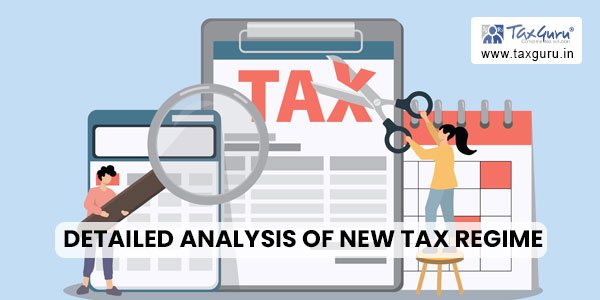Explore the detailed analysis of the new tax regime under sections 115BAC, 115BAA, and 115BAD for F.Y. 2023-24 A.Y. 2024-25. Understand the impact on taxpayers, key changes, and factors influencing the choice between old and new tax regimes. Stay informed to make well-informed decisions and comply with the latest tax regulations.
DETAILED ANALYSIS OF NEW TAX REGIME SECTION 115BAC, 115BAA, 115BAD F.Y. 2023-24 A.Y 2024-25…… updated on 15.04.2023.
Taxpayers now have to opt for New Tax Regime (lower tax rate with no deduction of various allowances and investments etc.) or Old Tax Regime (which allows deductions and allowances) and have to pay tax in accordance with such selection. However, taxpayers have been given further facility to switch between the two tax regimes every financial year, but this facility is not available to taxpayers having business income, wherein the option once chosen will apply to subsequent financial years. Moreover from ‘’Finance Act’’ 2023, the new tax regime shall be the default tax regime and therefore action is to be taken as stated herein:
The Finance Act 2023 provided more relief to the taxpayers adopting the new tax regime:
1. Increased rebate has been allowed on income up to Rs. 7 lakhs along with marginal relief available with no such change in old regime which continue at Rs.5 lakhs, means that individuals with incomes under Rs.7 lakh do not need to make any investments to qualify for exemptions as is the case in old regime.
2. Extended the benefit of standard deduction now up to Rs.50000 under new tax regime now to all salaried individuals also as available under old tax regime;
3. Increased basic exemption limit to INR 3 lakhs from the previous limit of INR 2.5 lakhs;
4. New lower tax rates / slabs for the new income tax regimeare:
0-3 lakh – nil
3-6 lakh – 5%
6-9 lakh- 10%
9-12 lakh – 15%
12-15 lakh – 20%
above 15 lakh- 30%
5. The tax rates in the New tax regime are the same for all categories of Individuals, i.e. Individuals & HUF upto 60 years of age, Senior citizens above 60 years upto 80 years, and Super senior citizens above 80 years. Hence no increased basic exemption limit benefit will be available to senior and super senior citizens in the New Tax regime.
6. Additional Health and Education cess at the rate of 4 % will be added to the income tax liability in all cases. Surcharge applicable as per tax rates below in all categories mentioned above:
10% of Income tax if total income > Rs.50 lakh
15% of Income tax if total income > Rs.1 crore
25% of Income tax if total income > Rs.2 crore
37% of Income tax if total income > Rs.5 crore
7. In Finance Act 2023, the highest surcharge rate of 37% has been reduced to 25% under the new tax regime (applicable from 1st April 2023). The taxpayers with income of more than 5 crore will be benefited paying 25% surcharge instead of 37% under New Tax Regime;
8. Income tax is levied on the income earned by all the individuals, HUF, partnership firms, LLPs and Corporate as per the Income tax Act of India. In the case of individuals, tax is levied as per the slab system if their income is above the minimum threshold limit (known as basic exemption limit).
9. List of common Exemptions and deductions “not allowed” under New Tax rate regime
Leave Travel Allowance (LTA)
House Rent Allowance (HRA)
Conveyance allowance
Daily expenses in the course of employment
Relocation allowance
Helper allowance
Children education allowance Other special allowances [Section 10(14)]
Professional tax
Interest on housing loan (Section 24)
Deduction under Chapter VI-A deduction (80C,80D, 80E and so on) (Except Section 80CCD(2))

10. Partnership firm or LLP
A partnership firm/ LLP is taxable at flat rate of 30%. With 12% Surcharges levied on incomes above Rs 1 crore as well as Health and Education cess at the rate of 4 % Note- There are no concessional rates introduced for firms / LLPs in new tax regime.
11. Companies:
Companies can opts for Section 115BAA , wherein the total income of a company has been calculated without claiming specified deductions, incentives, exemptions and additional depreciation @ 22%. In case, Turnover or Gross Receipt of the company is less than Rs. 400 crore in the Previous Year charged that @ 25% and Any other domestic company @ 30 %. Additional Health and Education cess at the rate of 4 % will be added to the income tax liability in all cases. Surcharge as applicable for companies provided that once the option exercised, it cannot be subsequently withdrawn
12. Certain resident co-operative societies: section 115 BAD Such co-operative societies can opts for Section 115BAD , wherein the total income of a society has been calculated without claiming specified deductions, incentives, exemptions loss or depreciation as per the conditions specified in sub- section(2) charged @ 22% provided that once the option exercised, it cannot be subsequently withdrawn.
13. However, the taxpayers under the new regime have to forgo exemptions if they opt for new tax regime. A total of 70 exemptions have been done away with in the new tax regime. These are Deductions/Exemptions on account of House Rent Allowance for individuals staying in rented accommodation, Interest on housing loan for self-occupied property, Leave Travel Allowance twice in block of four years, Children Education Allowance, the most commonly claimed deduction under section 80C for provident fund contribution, life insurance premium, school tuition fee for children, ELSS,PPF, and on specified investments, etc.
14. Exception is on interest paid on a housing loan taken for a rented-out property can be claimed as a deduction under section 24(b) in the new tax regime as well and NPS contribution u/s 80CCD(2) Exception is on interest paid on a housing loan taken for a rented-out property which can be claimed as a deduction under section 24(b) in the new tax regime as well and NPS contribution u/s 80CCD(2) including exemption available on voluntary retirement on gratuity and on leave encashment;
15. Check the exemptions: Out of all the exemptions that have been removed, taxpayers should check how many are applicable for him and how much money you can be saved by opting for those. This will help him to decide.
16. Investments at present have financial benefits of savings for wealth creation with tax benefits giving substantial return as available in the old regime. Now the tax saved on opting new tax regime can at least be invested in small savings schemes, mutual fund schemes etc along with a portion of the income to build up the corpus for old age i.e. investments should not be stopped even if tax benefit is not available, if opted for new regime.
17. With the further relief given in the Finance Act 2023, the new tax regime seems to be more attractive/beneficial for the salaried employees and to the taxpayers with lower tax slabs…. under the new regime, they will be liable to pay lower taxes, provided they forego their deductions and exemptions.
18. In any case, the new income tax regime is beneficial for people who make low investments Also, the new tax regime can largely benefit middle class taxpayers who have a taxable income say up to Rs 20 lakhs. Old regimeis a better option for high-income earners. This estimate is assessed considering the above reliefs now extended by Finance Act 2023 w.e.f. 1st April 2023 and therefore subject to actual working to be done for both old and new tax regime.
19. Taxpayers will still have the option of using the previous regime and would now need to do the Math to evaluate their tax liability under both the tax regimes and then decide accordingly.
20. Time of Selection of option of old vs new:
i) An employee can opt to choose for the new tax regime and intimate their employer at the beginning of financial year. Employees can change the option of selecting the tax regime every year. However if new tax slab regime is opted at the beginning of the year, it cannot be changed anytime during the year for TDS purpose, however the option can be changed at the time of filing of Income-tax return.
ii) Income from Business & Professional case of Business or profession income, the option to choose between the tax regimes is available only once for a particular business.
21. Optional New Tax Regime or Old Tax Regime:
1. The CBDT has issued Circular No 04/2023 dated 5th April, 2023 clarifying employer’s TDS obligation for Financial Year 2023-24.
2. The CBDT has clarified that an employer need to seek information from each of its employees regarding their intended tax regime whether new regime (low tax rates with no deduction of various allowances and investments etc.) or old regime (which permits deductions and allowances). Each employee is required to intimate its option to his employer for each year at the beginning of each year and upon such intimation by the employee to the employer, the employer has to compute the employee’s total income and deduct tax at source according to the option exercised by each of the employees.
3. Further in the absence of any intimation by the employee, the employer shall presume that the employee continues to be in the default tax regime i.e. new regime.
4. The employee shall still have the two option to choose old or new regime at the time of filing its tax return irrespective of the stand taken in such intimation furnished to the employer. While the salaried taxpayers will continue to have option to switch from every year, however, those with business or profession income, after opting for regular tax regime will have an option to move out only once.
5. It is applicable for TDS during FY 2023-24 and subsequent years.
22. Annual Information Statement AIS for Taxpayer now available on mobile from F.Y. 2023-24 onwards.
The Income Tax Authority have further provided facility of a new mobile App ‘‘AIS for Taxpayer’’ to provide easy access to Annual Information Statement to each of the Taxpayers. Now taxpayers can download this App from Google Play or Apple Store and will be able to access information uploaded therein and also can point out errors/ corrections in the AIS.
For business assesses some of the deduction which are not available are additional depreciation, contribution to national laboratory deduction under section 80C, 80D,80E, 80EB and 80G





